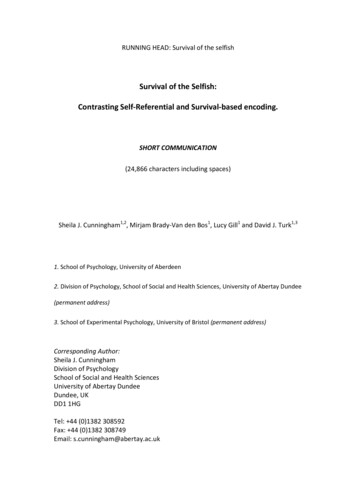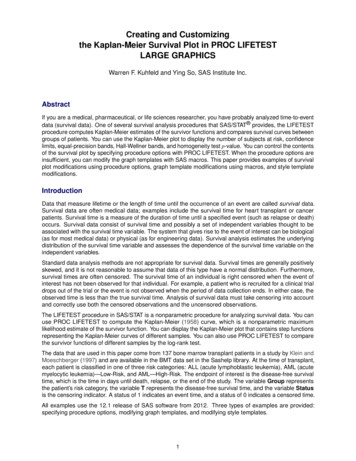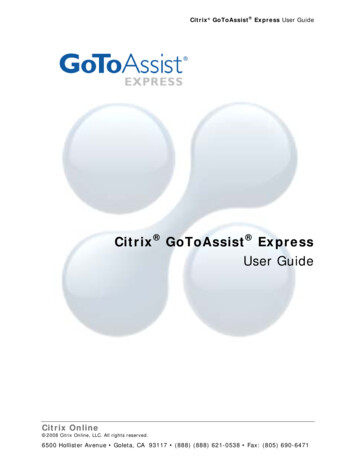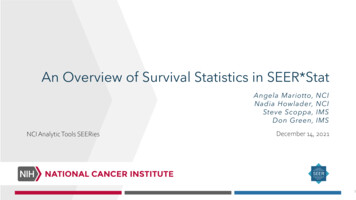
Transcription
Maximizing data survival in Unattended WirelessSensor Networks against a focused mobile adversaryRoberto Di Pietroa , Luigi V. Mancinib , Claudio Sorientec , Angelo Spognardid ,Gene Tsudikca Dipartimentodi Matematica, Università degli studi di Roma Tredi Informatica, Università “La Sapienza” Romac Computer Science Department, University of California, Irvined Equipe Planète, INRIA Rhône-Alpesb DipartimentoAbstractSome sensor network settings involve disconnected or unattended operation withperiodic visits by a mobile sink. An unattended sensor network operating in ahostile environment can collect data that represents a high-value target for theadversary. Since an unattended sensor can not immediately off-load senseddata to a safe external entity (such as a sink), the adversary can easily mounta focused attack aiming to erase or modify target data. To maximize chancesof data survival, sensors must collaboratively attempt to mislead the adversaryand hide the location, the origin, and the contents of collected data.In this paper, we focus on applications of well-known security techniques tomaximize chances of data survival in unattended sensor networks, where senseddata can not be off-loaded to a sink in real time. Our investigation yields someinteresting insights and surprising results. The highlights of our work are: (1)thorough exploration of the data survival challenge, (2) exploration of the designspace for possible solutions, (3) construction of several practical and effectivetechniques, and (4) their evaluation.Key words: Unattended WSN, data survival, security, mobile adversary,probabilistic analysis.1. IntroductionIn recent years, sensors and sensor networks have been extremely popularin the research community. Much of prior research explored various aspectsof Wireless Sensor Networks (WSNs), including: system architecture, routing,security, power-awareness and data abstraction. In particular, security issues inWSNs have received a lot of attention. One common assumption in prior WSNEmail addresses: dipietro@mat.uniroma3.it (Roberto Di Pietro),mancini@di.uniroma1.it (Luigi V. Mancini), csorient@ics.uci.edu (Claudio Soriente),spognard@inrialpes.fr (Angelo Spognardi), gts@ics.uci.edu (Gene Tsudik)Preprint submitted to ElsevierOctober 20, 2008
security research is that data collection is performed in, or near, real time. Inother words, a trusted entity (such as a sink) is assumed to be always present.Individual sensors submit their data to the sink either periodically or based onsome external trigger, e.g., a change in the sensed environment or an explicitrequest by the sink.Another emerging sensor network type involves sensor mobility and opportunistic connectivity among sensors as well as between sensors and the sink[1, 2, 3]. This concept is similar to Delay Tolerant Networks (DTNs). It is characterized by sensors’ inability to communicate with other sensors, for reasonssuch as: limited transmission ranges, power constraints or signal propagationproblems (e.g., line-of-sight limitations or physical obstacles).In this paper, we focus on WSN scenarios and applications that do not fitinto either the real-time data collection model or the opportunistic DTN-likemodel. We are interested in sensor networks where sensors are connected butthere is no real-time communication with the sink. We refer to such networksas Unattended WSNs or UWSNs. We narrow our scope even further to UWSNsoperating in a hostile – or at least untrusted – environment where the adversaryhas free reign. Specifically, the adversary has one central goal: to preventcertain data collected by sensors from ever reaching the sink. We elaborate onthis below.One example of hostile unattended environment could be a network of nuclear emission sensors deployed in a recalcitrant country (under, say, an international treaty) in order to monitor any potential nuclear activity. Another example is an underground sensor network aimed at monitoring sound and vibrationproduced by troop movements (or border crossings). One can also imagine anairborne sensor network tracking fluctuations in air turbulence and pressure todetect enemy aircrafts. Among the features that unify these examples is thelikely presence of a powerful – yet careful – adversary. Informally speaking, wesay that the adversary is powerful if it can subvert a number of sensors at will,while it is considered careful if it wishes to remain undetected in the process.Quite recently, the U.S. Defense Advanced Research Projects Agency (DARPA)initiated a new research program to develop so-called LANdroids [4]: smartrobotic radio relay nodes for battlefield deployment. LANdroid nodes are supposed to be deployed in hostile environment, establish an ad-hoc network, andprovide connectivity as well as valuable information for soldiers that would laterapproach the deployment area. LANdroids might retain valuable informationfor a long time, until soldiers move close to the network. In the interim, the adversary might attempt to delete or modify that information, without disruptingnetwork operations, so as to remain undetected.In such settings, the greatest challenge is to ensure data survival for longenough that it can be collected by the itinerant sink. Clearly, if the adversary isunable to break into (i.e., compromise) a single sensor or inhibit communicationbetween a sensor and an eventual collector or sink, it has no hope of destroyingthe data. However, we envisage a more realistic adversary who is aware ofthe origin(s) of targeted data and is also assumed capable of compromisingany sensor it chooses, up to a specific threshold (fraction or absolute number)2
of sensors, within a certain time interval. This type of adversary has beenstudied in the cryptographic literature where it is usually referred to as a MobileAdversary [5]. An entire branch of cryptography, called Proactive Cryptographyhas been dedicated to developing cryptographic techniques (e.g., decryption anddigital signatures [6, 7]) that remain secure in the presence of a mobile adversary.Although our adversary models are similar, the UWSN application domain isvery different from that in proactive cryptography (as described below), thusmotivating radically different solutions.Scope. This paper represents the very first attempt to develop cryptographicdefenses for coping with a focused mobile adversary in UWSNs. However, asbecomes clear throughout, this paper does not address a number of importantproblems. This is partly because of space limitations and partly due to thenovel nature of the topic and problem at hand. We expect that this paper willresult in follow-on investigations on our part as well on the part of the researchcommunity.We also stress that our work is oriented towards sensor networks and isnot particularly novel in terms of cryptography. Its novelty stems from applying well-known and accepted cryptographic tools to solving a novel networkingproblem.Our Contributions. This paper provides the following contributions:1. Problem Exposure: although some recent work [8] first brought the problem to light, it focused on trivial and intuitive data survival strategies. Incontrast, the present work delves much deeper into the problem and constructs effective and efficient countermeasures that achieve our main goal ofmaximizing data survival in UWSNs in the presence of a powerful mobileadversary.2. Novel Techniques & Analysis: we thoroughly explore the design space ofcryptographic solutions and – without resorting to expensive and/or exotictechniques – develop several practical and optimal (or near-optimal) datasurvival strategies. Our investigation yields some interesting results; forinstance, when using public key cryptography, continuously moving dataaround the network provides the same security of combining the following techniques: moving data just once, plus re-encryption. Further, ourevaluations of proposed techniques demonstrate a surprising degree of datasurvival even when the adversary is very agile and powerful, while the sensor network remains unattended for a relatively long time.Organization. Section 2 introduces our environment assumptions. Then, Section 3 explores potential data survival strategies for the UWSN, adversarialcounter-strategies and a number of design parameters. Section 4 investigatesencryption–related issues and parameters. Section 5 presents our analysis. Next,Section 6 overviews relevant prior work. Finally, Section 7 provides a summaryand some directions for future work.3
2. System AssumptionsIn this section we present our assumptions about the sensor network environment and the adversary.2.1. Network EnvironmentWe envisage a UWSN which operates as follows: Sensors are programmed to sense and collect data periodically. There isa fixed global periodicity parameter p denoting the time interval betweensuccessive sensing operations. Each sensor collects a single unit of data for each interval. In an UWSNcomposed of n sensors, we say, sensor sj collects data drj for interval r. The network is unattended. There exists a parameter q (q v p for someinteger v) which denotes the maximum time between successive visits ofthe sink or collector —we use the term sink from here on to mean both. As soon as each sensor off-loads its accumulated data to the sink, it erasesits entire storage. Moreover, the sink re-initializes all sensors’ secret material upon each visit. In other words, any secret values held by a sensorright before the sink visit are completely independent from those held afterthe visit. The network is connected at all times. Any two sensors can communicateeither directly or indirectly, via other sensors. Although we use the termUWSN, we make no assumption about the wireless nature of the network.Indeed, our results are independent from the underlying routing protocol. There are no power constraints. At least initially, we are not concernedwith power consumption of various survival techniques —this assumptionwill be re-considered later. Ample storage. Each sensor is equipped with enough storage to accommodate O(v) sensed data.As seen from our assumptions, even apart from the unattended nature of thenetwork, we are considering an emerging kind of sensor network not typicallyencountered in the research literature.2.2. Portrait of the AdversaryWe now focus on the description of the anticipated adversary. We refer toit as ADV from here on. Compromise power: ADV is capable of compromising at most k out of nsensors during any single interval. k may be a fixed integer value or a fraction of n —number of sensors in the network. Once ADV compromises asensor, and as long as it remains compromised, we assume that ADV reads4
all of its storage and monitors all incoming and outgoing communications.We do not assume that the subset of compromised sensors is clustered orcontiguous, i.e., concurrently compromised sensors can be spread throughthe entire network. Compromise Round & Collection Round: for ease of exposition and withoutloss of generality, we assume that the compromise and collection roundshave the same duration. Moreover, and also without loss of generality, weassume that they are synchronized, i.e., both types of rounds start andend at the same time. Network knowledge: ADV knows the composition and the topology of thenetwork. Limited erasure capacity: between any two successive sink visits (within vintervals) ADV can erase no more than a given number t of measurementsfrom the network. Erasing more than that, raises an alarm on the sinkand contradicts ADV’s goal of remaining undetected.1 No interference: except for the above, ADV does not interfere with communications of any sensor and does not modify any other data sensed by– or stored on – sensors it compromises; this assumption as well will bere-considered later. Atomic movement: ADV moves in one fell swoop, i.e., at the end of eachinterval it selects at most k sensors to compromise in the next intervaland migrates to them in one monolithic step. Note that the two sets ofcompromised sensors may intersect or even be the same. Our assumptionsabout adversary movements are similar to the one in [9]. Stealthy operation: ADV’s movements between intervals are unpredictableand untraceable. As it moves from one set of k sensors to the next, ADVleaves no trace behind. This implies that a compromised sensor releasedby ADV is fully operationalWith reference to the last item, we assume that ADV does not modifyany data it encounters as it compromises sensors. It also does not inject anydata of its own. An important consequence is that, in this paper, we are notaddressing the data authenticity problem. We are concerned only with datasurvival, which motivates hiding: (1) data origin, (2) data content, and (3) timeof data collection. The reason for hiding these three values is apparent – wewant to minimize information available to ADV as it roams around the UWSNlooking for the target data.We distinguish between a proactive and a reactive adversary. The latteris assumed to be dormant (inactive) until it gets a signal that certain data must1 Whereas, a few missing reports might be considered by the sink as to be a consequenceof sensor malfunctioning.5
be erased. As soon as this happens, ADV reacts and starts compromising, ineach round, up to k sensors. In contrast, a proactive ADV roams the networkahead of time, waiting for a signal to erase certain data. The reason for thisdistinction is discussed later on in the paper.Finally, in Table 1 we summarize the notation used in the rest of the paper.We use the terms round and interval interchangeably, to denote the time betweensuccessive sensor measurements.ni, jsir, r0drir 0S(di , r )Kir0UrvCrksize of the UWSNsensor indicessensor iround/interval indicesdata collected by sensor i at interval rsensor hosting dri at round r0 rkey used by sensor si at round rset of data items undecipherable by ADV in round r0number of rounds between successive sink visitsset of compromised sensors at round rmaximum size of Cr ; assumed constantTable 1: Notation Summary3. Strategies and Design ParametersIn this section we introduce possible strategies adopted by the adversaryto reach its goals and the countermeasures taken up by the network to ensuredata survival. We also survey other design parameters such as encryption,authentication and replication.3.1. Survival and Attack StrategiesOur main goal is to maximize survival probability for data collected by sensorsi at interval r (that is, dri ). Survival means that this data is eventually deliveredto the sink. At round r ADV learns from an external signal which data it hasto erase, namely, it learns both si and r. Unfortunately for us, ADV does notreveal the data it is interested in erasing; thus, we know neither of these values,except that 1 i n and 0 r v. We must therefore assume that all datais potentially targeted by ADV.Focusing strictly on non-cryptographic techniques [8] considered two intuitive data survival strategies:MOVE-ONCE: at every round r, each sensor sj collects data drj , randomly picksa sensor —that is going to become S(drj , r 1)— and sends drj to it. Thereafter,drj remains at its new “home” until the next sink visit.KEEP-MOVING: at each round r each sensor moves each hosted data itemseparately, i.e., for each data item that it stores (and collects), it picks a random6
sensor and moves there the stored item. As we show later in the paper, thisstrategy does not significantly increase data survival chances.Whichever survival strategy is used, one must assume that ADV is awareof it. Knowing the survival strategy lets ADV pick a counter-strategy thatmaximizes chances of deleting the target data. [8] considered several counterstrategies that, given a sufficiently large v (number of rounds between sinkvisits), guaranteed that ADV wins the game as long as data is kept as cleartext.These survival strategies vary only as far as exactly how many rounds it takesADV to win.The use of encryption allows us to hide the origin, the time of collection andthe content of sensed data. If ADV can not recognize target data, former attackstrategies no longer apply and ADV is forced to erase data blindly, i.e., to guess0which ciphertext hides the target data. In the analysis below, we use U r todenote the set of all encrypted data items that ADV can not decrypt at roundr0 . We stress that message eavesdropping or interception does not affect oursecurity analysis, since we focus only on the indistinguishability of messages.0The greater the size of U r , the higher the probability that the target data willpersist until the next sink visit. In particular, given t possible erasures, ADVhas probability Utr0 of succeeding. The survival strategy aims to increase the0size of U r . Whereas, ADV’s counter-strategy is to roam the network and learnas much information as possible in order to maximize the chances of finding0and erasing dri . To this end, ADV’s goal is to limit the growth of U r and ifpossible, even to decrease it.3.2. Design ParametersEncryption. In the context of this paper, the most important issue is encryption.If sensors use encryption in conjunction to hiding data location (by movingdata around), they can hide not only the contents of collected data but also theidentity of the sensor that collected it as well as the round identifier (i.e., thetime of collection). Use of encryption is a natural choice; however, it comes withcertain non-negligible costs, such as key management and the overhead due tocryptographic operations. Encryption also motivates certain assumptions andtechnicalities which we discuss in the rest of this paper.Authentication. Another important issue is authentication, i.e., whether thesink can establish with certainty both data integrity and data origin authenticity.As mentioned in Section 2.2, we are not dealing with authentication in thispaper. More concretely, we assume that all data is encrypted using PlaintextAware Encryption [10] whereby any modification (without knowledge of thesecret key) will produce gibberish upon attempted decryption.We expect that follow-on works will address richer adversary model whichallows ADV to modify existing data and/or inject fake data into compromisedsensors.7
Percom’08Di Pietro, et al.NOEncryptionYESTypeSecure againstProactive TruoudNsee/PicalRNG Typec***YESSYEYEYES*Key EvolutionNO**Key igure 1: Decision TreeReplication. The final parameter we consider is replication, i.e., whether sensors create multiple copies of sensed data before moving it to other locations.Replication has some obvious advantages and drawbacks. The main advantage is increased chances of data survival, while the main drawback is increasedstorage and communication overhead. Replication of cleartext data was previously studied in [8]. Although replication of encrypted data is more effectivethan cleartext replication for defending against our focused mobile adversary,we consider replication an independent issue and do not discuss it further inthis paper.4. Encryption Parameters and FeaturesWe are primarily concerned with encryption as a means of hiding the originand time of collection (and to a lesser extent, the contents) of sensed data.Furthermore, we assume that, regardless of the encryption details, encryptionis always randomized [11], which (informally) means that given two encryptionsunder the same key, it is unfeasible to determine whether the correspondingplaintexts are the same.We now discuss encryption features and parameters. To simplify the discussion, we show the “decision tree” in Figure 1 where leaves represent specifictechniques. Note that the asterisks (*) associated with the leaves provide anintuitive measure of the quality of the data survival strategy represented: the0more asterisks, the bigger the set U r .2 Justifications for the rankings – as well2 However, note that has a special meaning: the exact quality depends on the relationshipbetween r0 and k. In particular, for r0 n/k, it is better than that provided by a singleasterisk. On the other hand, if r0 n/k the quality is lower than that of all other techniques.8
as the meaning of the dashed arrow – are clarified below, in the course of ourdiscussion.As usual, the choice of public key or symmetric (shared key) algorithm is themain variable when introducing encryption. We remain agnostic with respectto this choice and consider both cases.4.1. Symmetric EncryptionOur construction with conventional encryption is straightforward:1. Each sensor sj shares a distinct initial key Kj0 with the sink.2. At round r, sensor sj senses data unit drj and encrypts it to produce Ejr E(Kjr , drj , r, sj , etc.).3. Finally, sj picks a random destination sensor sl and sends Ejr to it.4. If KEEP-MOVING strategy is used, sj sends each stored data item to random destination sensors.Since symmetric encryption is inherently invertible, we need to worry aboutwhat happens when ADV compromises sensor si which originated target datadri . By the time ADV compromises si , dri is off-loaded to another sensor S(dri , r0 )(assuming r0 is the current round). However, if si ’s key Ki0 does not change,as soon as ADV learns this key, it becomes capable of recognizing dri – bydecrypting its cyphertext with Ki0 – whenever, at some future round r0 , ADVcompromises S(dri , r0 ). We therefore claim that the security offered by symmetric encryption is the same as in the case of not using encryption. This iswhy Figure 1 shows a dashed arrow from the right-most leaf to top box, denoting the essential equivalence of using a constant (non-evolving) shared key forencryption and not using encryption at all.To cope with sensor compromise, we need a property commonly referred toas Forward Secrecy [12] which, in our case, can be easily obtained by evolving thekey in each round, using any suitable one-way function OW F ( ). Concretely,we introduce an additional step between steps 2 and 3 described above:2(a) sj computes Kjr 1 OW F (Kjr ) where OW F ( ) is a cryptographicallysuitable one-way function, such as SHA-2. Then, Kjr is deleted.A minor issue is how the sink would decrypt data, i.e., how it would determinewhich decryption key to use. This actually does not pose a problem since thesink has all initial keys of the form Kj0 . It can attempt to decrypt a ciphertextusing all n v possible keys. While this might seem excessive, we point out thatsymmetric encryption is very inexpensive and the sink is assumed to have nocomputational constraints.Unfortunately, symmetric encryption offers security only against a reactiveADV. To see this, consider a proactive ADV who roams the network for d nk erounds prior to receiving a signal that, at round r d nk e 1 sensor si generated target data dri . ADV has already “visited” all n sensors in previous d nk erounds. Therefore, it is able to derive each symmetric keys used by every sensor9
in round r.3 At this point, ADV just needs to find the current location of Eirand erase it, before the sink visits the network. Of course, this is the worst-casescenario where ADV is guaranteed to win. More generally, a proactive ADVdoes not necessarily have the luxury of d nk e rounds before receiving the signal.One possible, but limited, measure against a proactive ADV is super-encryption, i.e., further encryption of already encrypted (Eir ) data by the host sensor.The motivation is to address the case when, before getting the signal, ADVcompromises only either the originator si or the host sensor sj S(dri , r 1).If so, at round r 1, dri is stored at sj as:E(Kjr , Eir ) E(Kjr , E(Kir , dri , r, si , etc.))To recognize dri , ADV needs to decrypt both layers, which is impossible withoutknowledge of both Kir and Kjr . Note that the above implicitly refers to theMOVE-ONCE strategy. It is easy to extend super-encryption to the KEEPMOVING.In summary, symmetric super-encryption offers only limited help against aproactive ADV. Its exact effectiveness is assessed below in Section 5.2.3.4.2. Public Key EncryptionIn the past, public key encryption was often avoided in the sensor networksecurity literature since its higher cost was viewed as a poor match for low-endsensors. However, due to recent advances, public key encryption is becomingmore appealing [13]. Furthermore, as we show below, use of public key encryption offers a level of security unattainable with symmetric encryption. The basecase for public key encryption has the following features:1. The sink has a long-term public key, P Ksink , known to all sensors.2. At round r, sensor sj collects data drj and encrypts it to produce Ejr E(P Ksink , Kjr , drj , r, sj , etc.) 4 .3. As in the symmetric case, sj picks a random destination sensor sl and sendsEjr to it.4. As before, with KEEP-MOVING, all stored data items are sent to randomsensors as well.Note that sensors have no secret (private) keys of their own – they merely use thesink’s public key to encrypt data. However, even this simple approach resultsin ADV being unable to distinguish target data among all other encrypted datait finds on compromised sensors.Since ADV does not know the sink’s decryption key (SKsink ), the only wayit can attempt to detect target data is by trying to encrypt its duplicate5 underthe sink’s public key, P Ksink .3 Since knowing a sensor’s key for a given round allows it to derive the same sensor’s keysfor all subsequent rounds.4 K r is the random number provided at round r by the random number generator of sjj5 We assume that ADV can easily guess the actual sensed data dr .i10
This is where our randomized encryption assumption comes in handy. Withrandomized encryption, each encryption operation involves generating a onetime random number and folding it into the plaintext (e.g., as in OAEP [11])such that, without knowledge of that unique random number, it is computationally unfeasible to re-create the same ciphertext. Consequently, ADV is unableto distinguish among different encrypted values it finds on compromised sensors.There is, however, a crucial security distinction based on the source of random numbers. If random numbers are obtained from a strong (fully or, at leastpartially, physical) source of randomness, then we can achieve the maximumlevel of security — we also assume that the random numbers are sufficientlylong to make exhaustive guessing computationally unfeasible, i.e., at least 128bits. To argue this claim informally, consider that a true random number generator (TRNG) generates information-theoretically independent values. Thatis, given an arbitrarily long sequence of consecutive TRNG-generated numbers,removing any one number from the sequence makes any guess of the missingnumber equally likely.On one hand, the only way for proactive ADV to recognize Eir is if thecompromised set Cr includes si at the exact round r when ADV receives thesignal. This is, indeed, the highest level of security we can possibly hope toachieve —in other words, ADV can win only due to dumb luck. If, on the otherhand, random numbers are obtained from a pseudo-random number generator(PRNG), the resulting security is equivalent to that of the symmetric encryptioncase with key evolution. This is because a typical PRNG produces numbersby starting with a seed value and repeatedly applying a suitably strong oneway function. Hence, it is functionally equivalent to the key-evolution featuredescribed in the previous section. This leads us to conclude that: if sensors haveno real source of randomness, there is no reason to use public key encryption,since it costs more than symmetric encryption and does not offer better security.However, an interesting feature of public key encryption is that some techniques(e.g., [14]) allow what is referred to as re-encryption. In our context, this meansthat a sensor which receives an already-encrypted data from another sensor, canre-encrypt that data such that the previous sensor would be unable to recognizeits own encrypted data thereafter. Two advantages of using re-encryption are: It does not require multiple decryption operations to obtain the cleartext(unlike super-encryption). It does not cause ciphertext expansion.The use of re-encryption is beneficial considering that ADV, as it breaks intosensors, might attempt to copy and remember encrypted values that sensors inCr generate, encrypt and off-load during the same round: that way it coulddetect them later. If all sensors re-encrypt all values they receive from others,ADV is placed at a further disadvantage. Moreover, if all data stored on asensor are re-encrypted at every round, we further reduce the chances of ADVto find out the data it is looking for. We demonstrate the effects of the abovestrategy in Section 5.3.11
Unfortunately, re-encryption imposes a peculiar limitation: it precludes theuse of hybrid (envelope) encryption. By hybrid we mean the way that public keyencryption is typically used in practice: a one-time symmetric key is generatedand encrypted using the public key, and the bulk data is then encrypted usingthe said symmetric key. Hybrid encryption produces a two-part ciphertext:public and symmetric. Re-encryption can be applied to the former but not tothe latter. (Of course, super-encryption can be used instead, but that wouldnegate all advantages of using re-encryption.) Therefore, re-encryption is usefulonly if data (dri ) is sufficiently short to fit into a single public key encryptionblock.65. Analysis and DiscussionIn this section we analyze the cryptographic techniques outlined above. Indoing so, we explore the leaves of the decision tree in Figure 1, and provide survival probability of the target data for both MOVE-ONCE and KEEP-MOVINGnetwork defense strategies. We start describing the experimental te
Maximizing data survival in Unattended Wireless Sensor Networks against a focused mobile adversary Roberto Di Pietroa, Luigi V. Mancinib, Claudio Sorientec, Angelo Spognardid, Gene Tsudikc aDipartimento di Matematica, Universit a degli studi di Roma Tre bDipartimento di Informatica, Universit a \La Sapienza" Roma cComputer Science Department, University of California, Irvine




![[ST] Survival Analysis - Stata](/img/33/st.jpg)





